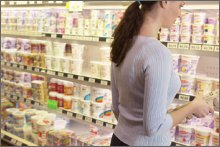How NOT to Get Ripped Off at the Grocery Store
by www.SixWise.com
No matter how much you trim your budget, one expense that's
sure to remain is food. But how much you spend on groceries
each month is not fixed, and can vary by 15-20 percent or
more. So because the grocery stores consider it their job
to get you to spend more money, it is your job to keep your
wits about you to avoid getting ripped off (especially on
those grocery trips when you just wanted a gallon of milk,
and left with five bags full of impulse buys).
It's surprisingly easy to save a significant amount of money
on your food bill (even up to $100 a month). Here's how.
|

Don't be afraid to try generic brands to save money
-- they're often the same as higher priced name-brand
versions. But do read labels in case of imitation ingredients.
|
Check your receipt. Scanned items do not always ring
up at the correct price. Watch the prices as they come up,
and then check your receipt for those you missed, to be sure
sale and other items come up at the right price and quantities
are correct.
"I can't say it's widespread, but I do get reports of
people saying they check grocery bills, and very often they
find mistakes ... And, 4 to 1, they
are in favor of the store," says Gary Foreman,
publisher of "The Dollar Stretcher" Web site.
Resist Impulse Buys. Grocery stores purposely set
up enticing displays of expensive cookies, crackers and other
packaged foods hoping to coax you into buying something on
a whim. Making a list and sticking to it will help you to
avoid such impulse buys.
Also be aware that grocery stores purposely place common
items all the way in the back of the store, so you have to
walk down the aisles to get there. The more snacks, cereals
and other processed foods you're exposed to, the greater the
chances that you'll grab something not on your list. One way
around this is to only shop at the outer perimeter of the
store. This is where you'll generally find the lower priced,
and healthier, items like meat, produce and dairy. Processed
foods are generally on the interior.
"Organize the shopping list to match the layout of the
store to minimize time needed to retrace steps and to decrease
impulse purchases," said Mary Meck Higgins, Kansas State
University Research and Extension nutrition specialist.
Don't Shop Hungry. Even with the best intentions,
it will be hard not to over-buy when you grocery shop on an
empty stomach. Grocery stores know this and may entice you
further with the smell of fresh bakery items and breads. Try
to eat something before you go, or at least drink some water.
" ... Purchases often are impulse buys that can add
to the grocery bill unnecessarily," said Higgins. "Impulse
purchases also can increase when shoppers are hungry or shop
without a list."
Look at the whole shelf. Stores place the items they
want you to buy most--the ones that give them the most profit--where
they're easiest for you to see: between knee- and shoulder-height.
"The highest markup items are the ones at about chest
level--to make it really easy for you to grab it and toss
it in the cart," says Foreman.
Be sure to look at products on the upper and lower shelves,
too. This is where you're likely to find a good product at
a lower price.
"The old saying, 'look high or
low to save dough' still fits," said Higgins.
|

Look for produce that's in-season and fresh--this will
be your best buy.
|
Buy generic. Often, generic products contain the same
ingredients as name-brand versions at a fraction of the price.
They may even have come from the same factory. All you need
to do is compare the nutrition information on packages. If
the ingredients are the same, the product probably is as well.
Do watch out for extra additives or imitation ingredients,
though--some generic versions, for instance Parmesan cheese
in a carton, may contain lower quality ingredients or more
additives than the real thing.
Make sure sales will save you money. Don't assume that just
because something is on sale (or comes in a "bulk"
container) it's a good deal. Sometimes the generic version
or a different sized container will be a better deal than
the sale item. Check the unit price (usually found right on
the shelf's price label) of each item to find out how much
you're actually paying. And, if the item turns out to be a
bargain but the store has run out, you can, and should, request
a rain check to use on your next visit.
Only buy groceries. Grocery stores are best saved
only for groceries. Toiletries like toothpaste, shaving supplies
and soap and other health and beauty products are typically
significantly cheaper at drugstore chains than at grocery
stores.
Find a store that matches prices. Some grocery stores will
match competitors' prices, though they may not advertise this
practice. "Find a store in your area that will honor
all competitors' ads," says Ellie Kay, author of "Shop,
Save, and Share."You'll save money, time and gas."
Recommended Reading
Butter
Flavoring Can Cause Lung Disease: Diacetyl, a Chemical Additive
to Watch Out For
How
to "Degunk" Your Personal Finances
Sources
Kansas
State University Research and Extension
MSN
Money
Ten
Money-Saving Grocery Shopping Tips